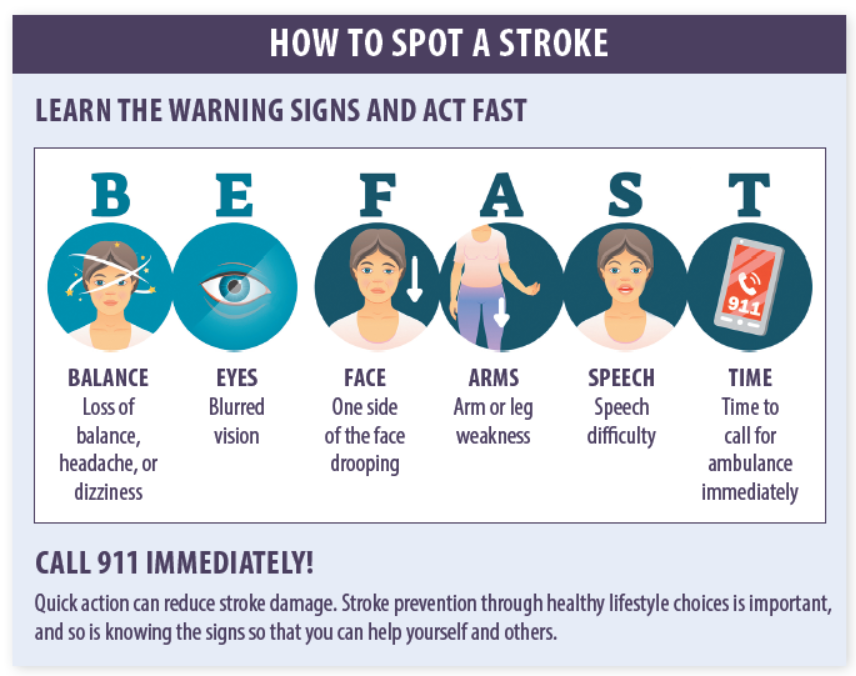On average, someone in the United States has a stroke every 40 seconds. While there are numerous factors that increase risk (including high blood pressure, diabetes, heart rhythm disorders, high cholesterol, exposure to tobacco, physical inactivity, and kidney disease), diet is a major modifiable risk factor for stroke.
Stroke Basics: There are two main kinds of strokes, ischemic and hemorrhagic. The more common ischemic stroke occurs when a blood vessel in the brain is blocked by a clot or plaque build-up, restricting blood flow. Hemorrhagic stroke involves a rupture of a blood vessel in the brain, allowing blood to leak out. Stroke can cause death, partial paralysis, and weakness, and interfere with speech, thinking, attention, and memory. The best way to prevent a stroke is to maintain good overall cardiometabolic health – this means being physically active, avoiding exposure to tobacco, and controlling things like blood pressure, cholesterol and blood sugar levels, and weight through diet (and medication when appropriate).
Follow these tips to reduce stroke risk:
- CHOOSE A HEALTHY DIET. Center your eating plan around the types of vegetables, fruits, whole grains, legumes, nuts, plant-based proteins, lean animal proteins, and fish you enjoy. Limit refined carbohydrates, processed meats, and sweetened drinks. Use the Nutrition Facts label on packaged foods to cut back on sodium and added sugars.
- BE PHYSICALLY ACTIVE. Aim for at least 150 minutes of moderate-intensity aerobic activity or 75 minutes of vigorous activity each week.
- WATCH YOUR WEIGHT. Lose weight if you’re overweight or obese. Start by identifying calories you can give up and moving more.
- LIVE TOBACCO-FREE. If you don’t smoke, vape, or use tobacco products, don’t start. Seek help if you’re having trouble quitting.
- MANAGE CONDITIONS. If you have high blood pressure, high cholesterol, high blood sugar, diabetes, or other conditions, it’s very important to work with your health care team to make lifestyle changes.
- TAKE YOUR MEDICINE. Take all medications as directed. But don’t take aspirin as a preventive measure unless your doctor tells you to.
- DO SOME MATH. Divide the grams of Total Carbohydrates on the Nutrition Facts label by the grams of Dietary Fiber. Foods with results less than 10 tend to be the best choices.
Foods, Nutrients, and Stroke: A number of studies have looked at intake of specific foods and nutrients in relation to stroke risk. A recent analysis of data from the EPIC study, a large prospective cohort study that included over 400,000 participants across nine European countries, found that higher consumption of fruits and vegetables, dietary fiber, and dairy foods (milk, yogurt, cheese) was associated with lower risk of ischemic stroke. Higher intake of nuts, olive oil, and fish have all been associated with lower risk of stroke. Meta-analyses found that higher dietary intake of potassium and flavonols (both common in plant foods like fruits and vegetables) were associated with lower risk of stroke.
In a study from China, people who cut back moderately on salt intake had significantly lower ischemic stroke risk than those whose intake of salt stayed relatively stable.
Dietary Patterns: The authors of the EPIC study mentioned above identified the importance of overall food quality and dietary patterns, rather than isolated single nutrients, in contributing to the risk and burden of stroke. “As with most disorders, there is no one food or nutrient that we can count on to lower stroke risk,” says Alice H. Lichtenstein, DSc, director of the Cardiovascular Nutrition Lab at the Jean Mayer USDA Human Nutrition Research Center on Aging and executive editor of Tufts Health & Nutrition Letter. “Putting together all the components of a healthy diet in a way that is consistent with personal preferences (referred to as a dietary pattern) while remaining physically active and achieving a healthy body weight is the best approach to lower our stroke risk.”
A recent study published in the journal Neurology found following a vegetarian dietary pattern was associated with lower risk of stroke, but other dietary patterns, like a Mediterranean-style diet or the DASH diet, are also associated with better cardiometabolic health and lower stroke risk. That’s because, in general, healthy dietary patterns have similar components identified as associated with lower stroke risk: they are high in fiber and flavonol rich foods (such as fruits, vegetables, whole grains, legumes, and nuts/seeds) and unsaturated fats, and low saturated fat, cholesterol, refined carbohydrates, added sugars and sodium.


























very good analysis of diet good health is not one thing but many fact;ors evaluated to gether
THIS ARTICLE IS OUT-OF-DATE. EXERCISE 64 MINUTES PER DAY IS THE CORRECT STANDARD.
We follow these important recommendations! We are active and in our early 90s. Thank you for your continued support. Ralph and Margaret